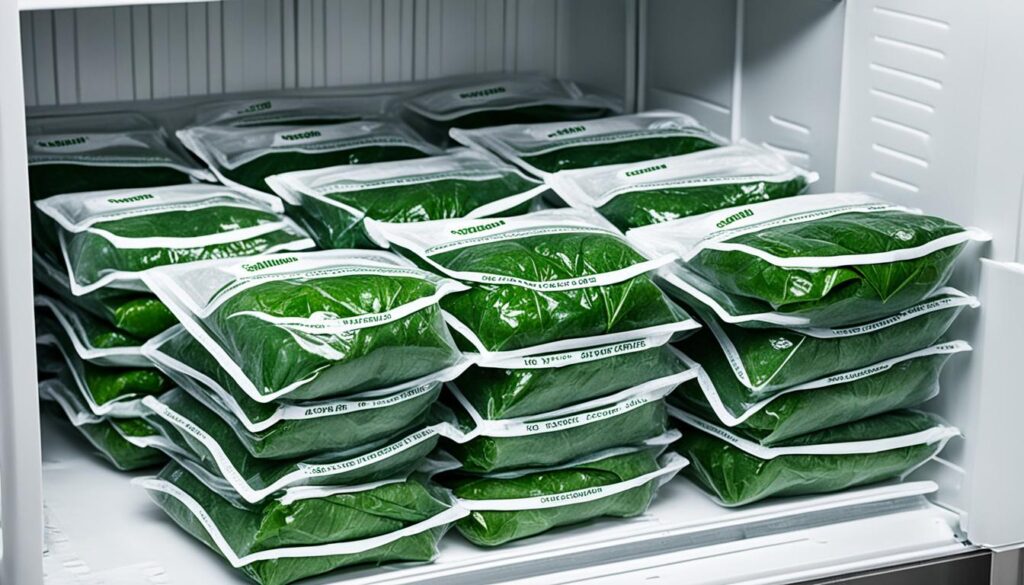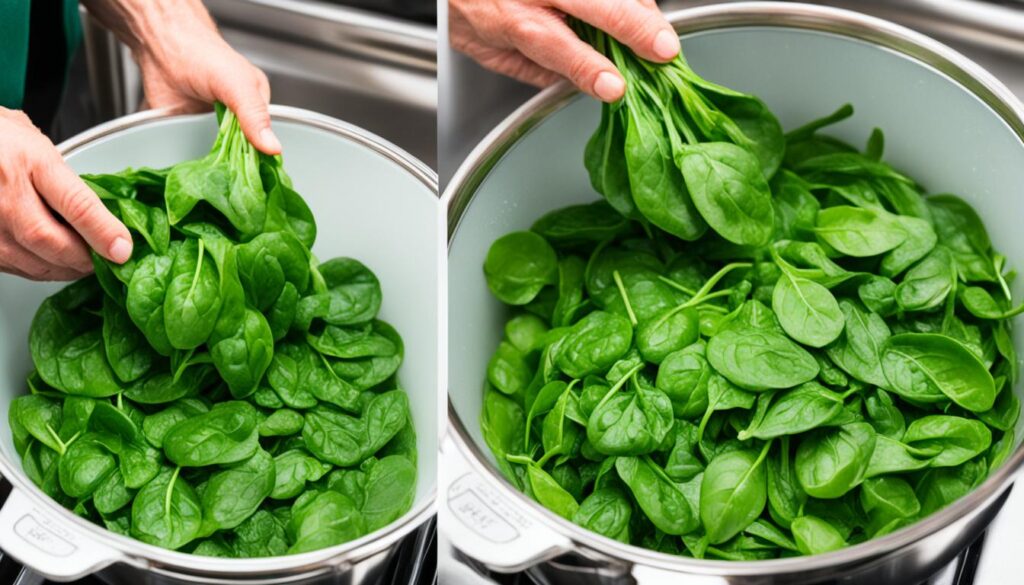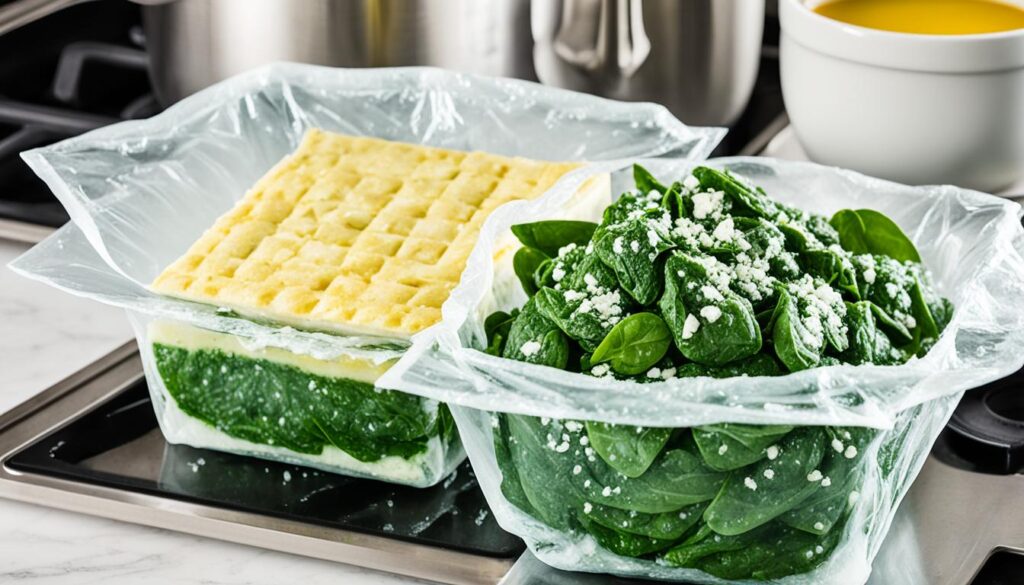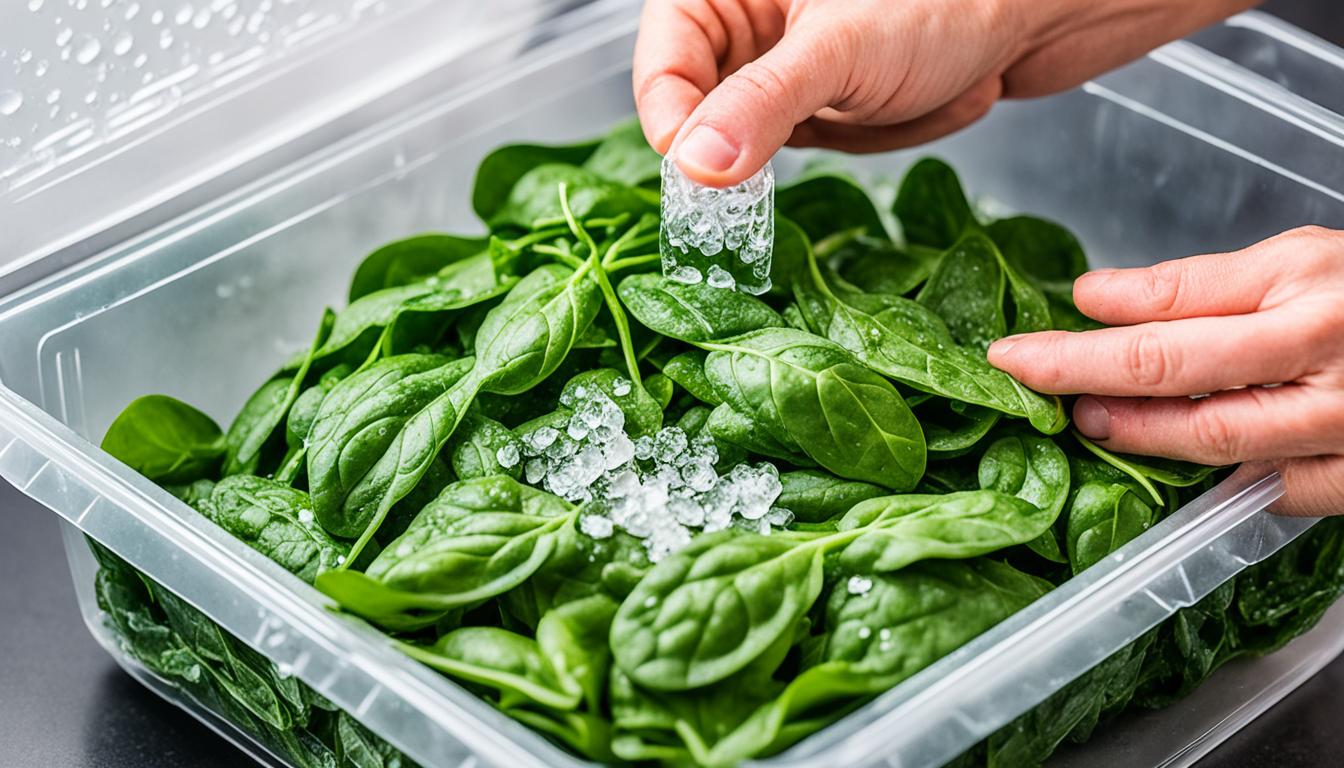Freezing fresh spinach keeps its taste and nutrients, cutting down on waste. It’s perfect for when you have extra spinach or want to store some leafy greens for later. You don’t have to blanch spinach to freeze it, so it stays fresh and green.
Key Takeaways:
- Freezing spinach is a great way to avoid waste and keep it readily available.
- There is no need to blanch spinach before freezing if you plan to use it within six months.
- Properly washing, drying, and packaging the spinach is crucial for maintaining its quality.
- Thawed spinach is best suited for cooked dishes like soups, stews, and pastas.
- Frozen spinach can be used in a variety of recipes, including smoothies, dips, and quiches.
Freeze spinach without blanching if you’ll eat it within six months. Blanching, or boiling briefly, increases freezer life to 14 months. But, if it’s a short stay in the freezer, blanching isn’t a must.
Blanching prevents spinach from decaying. Yet, it might make spinach softer when it thaws. For a crispier outcome, avoid blanching.
Begin by washing spinach well to remove dirt. Then, dry it thoroughly to stop quality damage. A salad spinner works, or use paper towels.
After drying, put the spinach in a freezer bag or a container. Remove air and seal tight to stop freezer burn. Lightly crush the bag for easy use later.
No need to thaw frozen spinach. Drop it straight into smoothies or cooked dishes. It becomes soft when thawed, ideal for meals like stews and pies.
Frozen spinach offers nutrients year-round. Each serving has 25 calories and it’s low in fat but high in fiber and protein. It’s great for many recipes, from pasta to quiches.
Don’t waste extra spinach. Freeze it using these easy tips. This way, you always have spinach ready to add to your cooking.
Why Freeze Spinach?
Freezing spinach is a great way to always have this healthy green around. Use the right methods, and spinach can last a long time in the freezer. This means you can enjoy spinach without it going bad.
Freezing spinach saves you money and cuts down on food waste. Instead of throwing away bad spinach, freeze it. This keeps its nutrients and flavor. With fresh spinach at $3.89 a pound from places like Costco, you can stretch your food budget further.
If you enjoy cooking or making smoothies, frozen spinach is a must-have. It adds nutrients to meals like stews, casseroles, and pies.
Did you know freezing spinach keeps its key nutrients? Spinach is low in calories but high in fiber and protein. By freezing it, you lock in these benefits. So, you can still be healthy by using it in your dishes.
Freezing spinach means you can enjoy it any time of the year. You can keep it up to six months without blanching, and up to 14 months if you do blanch. This way, you never run out of spinach for your meals.
Freeze spinach in ice cube trays for easy use. Add these cubes to your smoothies. It’s a simple and quick way to get more nutrients each day.

How to Freeze Spinach
Freezing spinach is a great way to keep it fresh and full of nutrients. You can freeze it in two ways: by freezing whole leaves or by pureeing it. Both ways are easy, and you don’t have to blanch the spinach if used within six months.
To freeze whole leaves, first wash them well. Ensure they are completely dry to avoid freezer burn. Then, put them in airtight containers or freezer bags, pressing out air before sealing.

For pureed spinach, blend the leaves with a bit of water until smooth. Store the puree in ice cube trays or small containers. This way, you can easily add it to any recipe.
Remember to always label containers with the freezing date. This helps you keep track of how fresh the spinach is.
Frozen spinach can stay good for up to six months. If you blanch it before, the quality can last up to 14 months. Blanching involves briefly cooking the leaves and then cooling them before freezing.
Thawed spinach is a bit softer than fresh. Use it in cooked dishes, not raw, for best results. Thaw it by rinsing under cold water or adding directly to recipes.
In short, freezing spinach is a smart move. With good prep and storage, you’ll always have this healthy green available.
Tips for Using Frozen Spinach
Frozen spinach is perfect for cooked dishes but less ideal for raw food like salads. It’s great for adding both flavor and nutrition to soups, stews, and more. Here’s how to use it:
- Thawing: There are a few ways to thaw frozen spinach. You can run it under cold water until it softens. Or, you can simply add it to smoothies for an extra health boost.
- Direct Use: A cool thing about frozen spinach is that you don’t always have to thaw it. You can drop it straight into your cooking. This saves you precious time.
- Measuring: Need a certain amount of spinach for a recipe? Just squash the frozen leaves to measure. This eliminates guesswork when you’re cooking.
- Drying: It’s essential to dry spinach well before freezing. This step keeps ice crystals at bay. Thus, maintaining its quality is key.
- Storage: Use freezer bags to store frozen spinach. Choose the size based on how much you’ll use. Squeeze out the air before sealing to keep it fresh.
Frozen spinach lasts a long time and fits into many recipes. It beefs up the nutrition in your meals and cuts down waste. So, venture into cooking with frozen spinach. You’re bound to find delicious ways to use it in your dishes.

Other Leafy Greens to Freeze
You can freeze more than just spinach. Other greens like kale, Swiss chard, and cabbage are great for freezing too. This keeps them fresh and ready to eat all year.
Freezing greens stops them from going to waste. They keep well for up to a year in the freezer. So, you can add them to dishes anytime.
To freeze these greens, start by washing them. Then, blanch them quickly in boiling water, followed by a cool bath in ice water. Squeeze out excess water, and pack them up for freezing.
Blanching helps the greens keep their color and nutrients. Boil them for about 2 minutes, and they’ll stay healthy.
Make sure to remove as much water as you can after blanching. This keeps your greens from getting freezer burn. It also keeps them tasting good.
Choosing how to store your greens for freezing is up to you. You can use freezer bags, containers, or silicone trays. Just be sure to measure out portions and remove air. This prevents freezer burn.
Even though frozen greens might feel different, they’re still good for you. They keep their nutritional value, which is the most important part.

Conclusion
Freezing spinach is a great way to keep this nutritious green on hand for a long time. The process is simple: wash it, divide into portions, put in bags, and label. This way, you’ll always have spinach ready to use.
Frozen spinach is both economical and time-saving. It’s perfect for dishes like Spinach Squares or Twice Baked Potatoes. You can add it to your cooking without thawing first, making meal prep easier.
When you freeze spinach, it keeps more of its nutrients than you might think. Freezing spinach keeps its vitamin C levels high. This actually makes it more nutritious than fresh spinach that might have lost nutrients over time.
If you’ve got extra spinach, freezing it is a smart choice. When frozen correctly, spinach can last up to a year. This means you can always have a healthy ingredient ready for your meals.
